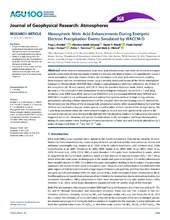Mesospheric nitric acid enhancements during energetic electron precipitation events simulated by WACCM‐D
Orsolini, Yvan; Smith-Johnsen, Christine; Marsh, Daniel R.; Stordal, Frode; Rodger, Craig J.; Verronen, Pekka T.; Clilverd, Mark A.
Peer reviewed, Journal article
Published version

Åpne
Permanent lenke
https://hdl.handle.net/1956/19006Utgivelsesdato
2018-07Metadata
Vis full innførselSamlinger
Originalversjon
https://doi.org/10.1029/2017jd028211Sammendrag
While observed mesospheric polar nitric acid enhancements have been attributed to energetic particle precipitation through ion cluster chemistry in the past, this phenomenon is not reproduced in current whole‐atmosphere chemistry‐climate models. We investigate such nitric acid enhancements resulting from energetic electron precipitation events using a recently developed variant of the Whole Atmosphere Community Climate Model (WACCM) that includes a sophisticated ion chemistry tailored for the D‐layer of the ionosphere (50–90 km), namely, WACCM‐D. Using the specified dynamics mode, that is, nudging dynamics in the troposphere and stratosphere to meteorological reanalyses, we perform a 1‐year‐long simulation (July 2009–June 2010) and contrast WACCM‐D with the standard WACCM. Both WACCM and WACCM‐D simulations are performed with and without forcing from medium‐to‐high energy electron precipitation, allowing a better representation of the energetic electrons penetrating into the mesosphere. We demonstrate the effects of the strong particle precipitation events which occurred during April and May 2010 on nitric acid and on key ion cluster species, as well as other relevant species of the nitrogen family. The 1‐year‐long simulation allows the event‐related changes in neutral and ionic species to be placed in the context of their annual cycle. We especially highlight the role played by medium‐to‐high energy electrons in triggering ion cluster chemistry and ion‐ion recombinations in the mesosphere and lower thermosphere during the precipitation event, leading to enhanced production of nitric acid and raising its abundance by 2 orders of magnitude from 10−4 to a few 10−2 ppb.